Garden wall ideas to turn this finishing touch into a feature in its own right
Garden wall ideas are a way to elevate your outdoor space, and these expert landscapers explain how
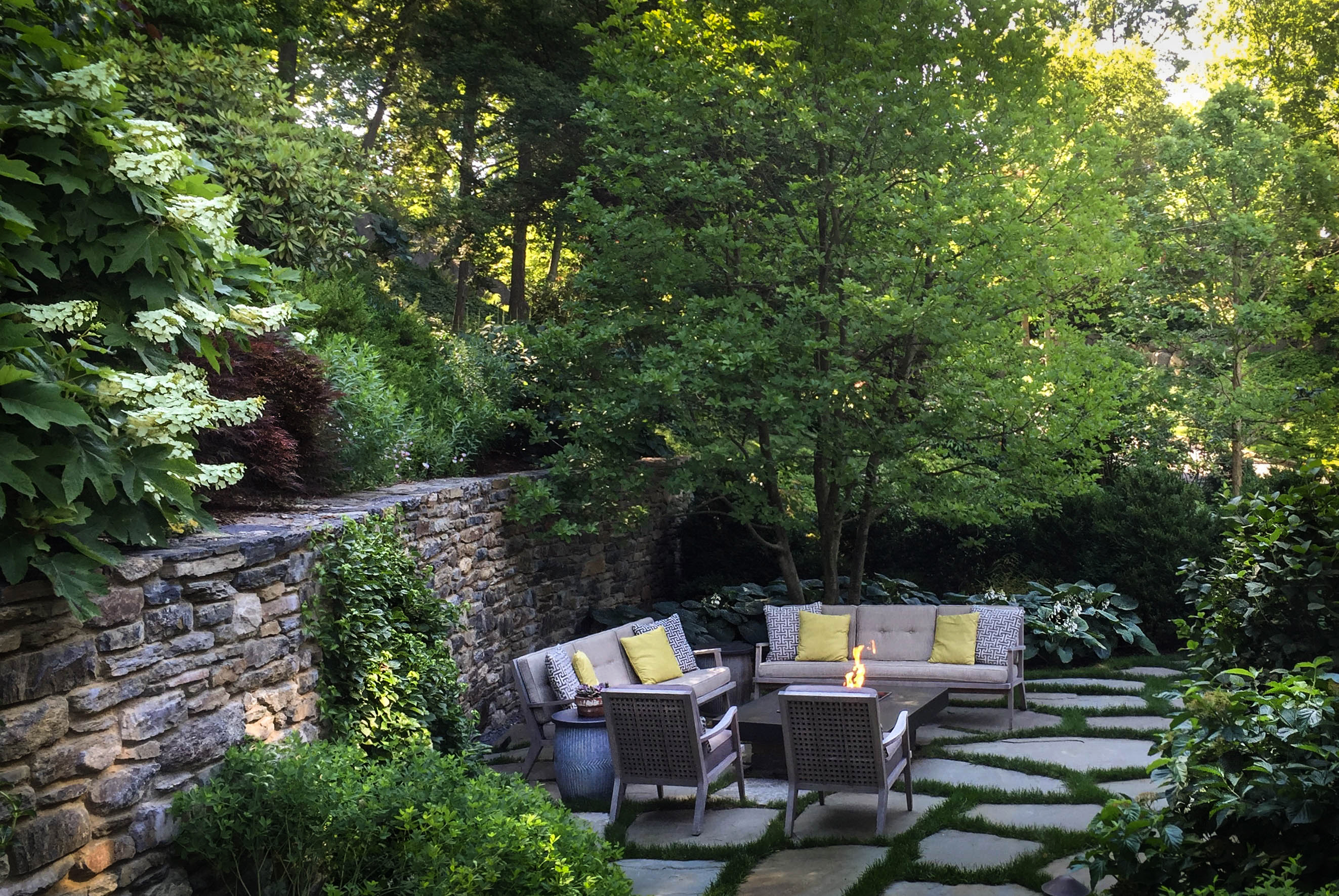
Putting a little care into your garden wall ideas can be incredibly useful. Walls serve many purposes - offering security, privacy, sound proofing, soil retention, boundary setting and more. But care and creativity is required in order to avoid a look that feels heavy or overly solid.
Fortunately, there are plenty of ways to break it up - not literally - while adding interest and extra utility to the wall. To make it cohesive with the rest of your property, the New York-based landscape architect Renée Byers recommends starting by considering the style of the house: “Can you tie [the wall design] into the stone work of the property, or the architecture, or, say, the rocky outcrop in the distance?” Then, she says, “put together a palette of materials - for the stone, the furniture, the paving - so that it’s seamless.”
As with garden fencing ideas, there are more possibilities here than might at first seem likely. Why not pay attention to this surprising finishing touch?
Garden wall ideas
1. Transform a block wall into a green wall
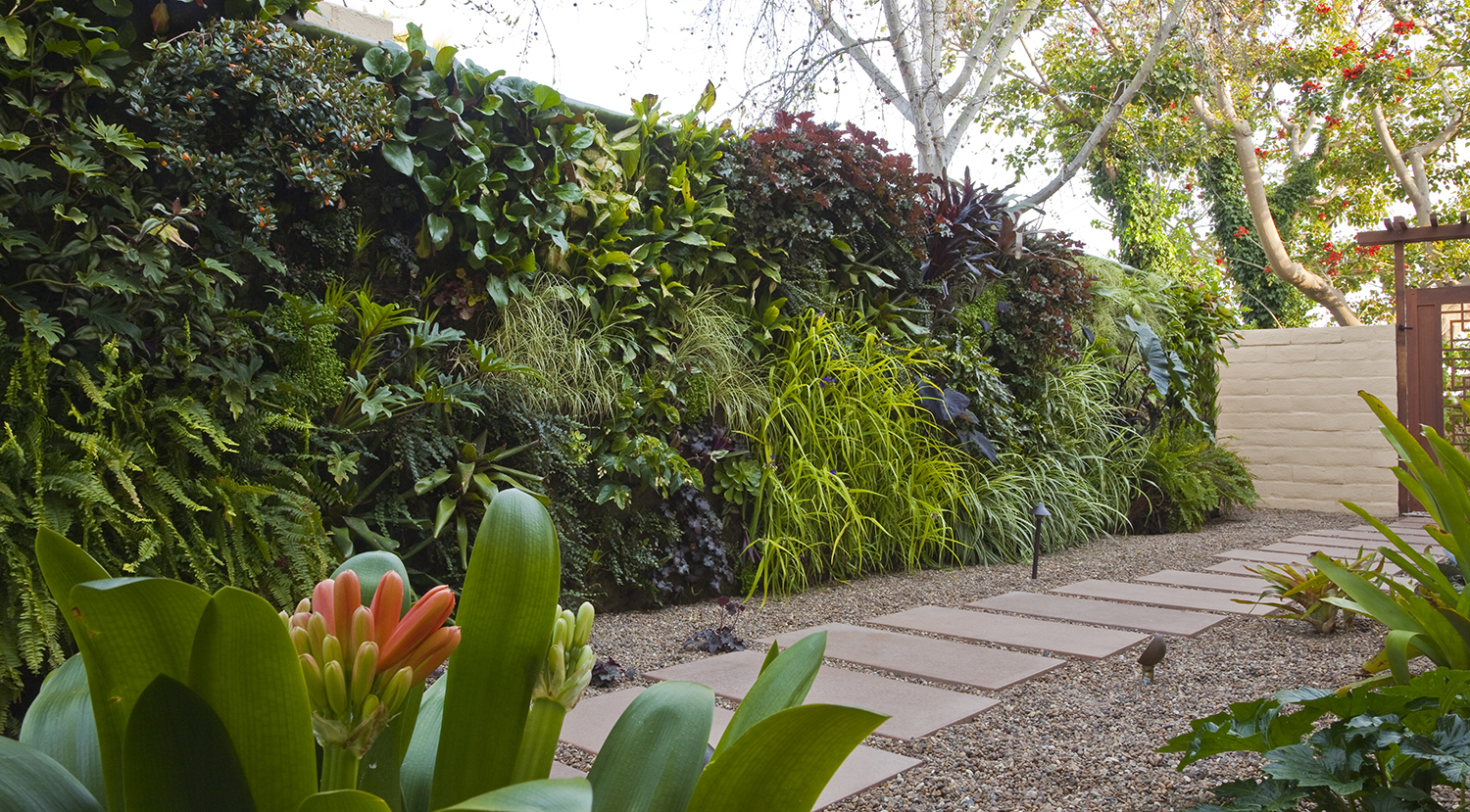
Design by Amelia B. Lima
Most people are becoming more aware of the mental health benefits of being amongst greenery. So when faced with the choice between a tall, gray block wall and a lush green living wall, it was an easy call for the San Diego-based landscape designer Amelia B. Lima.
This vertical garden is situated in Amelia’s own narrow side yard: “It was the perfect solution,” she says. “This 40-foot long green wall was built to conceal the block wall that separated the yard from the sidewalk outside the property, which was overlooked by the dining room and kitchen.” Her priority, she adds, was to create something “beautiful that was also sustainable for the local Mediterranean climate”.
The 260-square-foot living wall is a prime example of current garden trends in action. It features a combination of soil-less plants, chosen for their ability to grow, such as Epiphytes or Lithophytes. It also has those with a preference for a moist environment. Amelia used Acorus, Alocacia, Begonia, Clorophytum, Colocacia, Tradescantia, Philodendron, Aechmea, and Adiantum, and others, to create a “technicolor tapestry”.
A tank at the wall's base collects and re-circulates the runoff several times a day, making it less water-intensive, and whenever fresh water is added, a soluble fertilizer solution is injected into the system. The key thing to watch out for, says Amelia, is “for something to go wrong with the water recirculation and the wall to dry up - these plants have no ability to find water on their own.”
2. Create a herb box wall
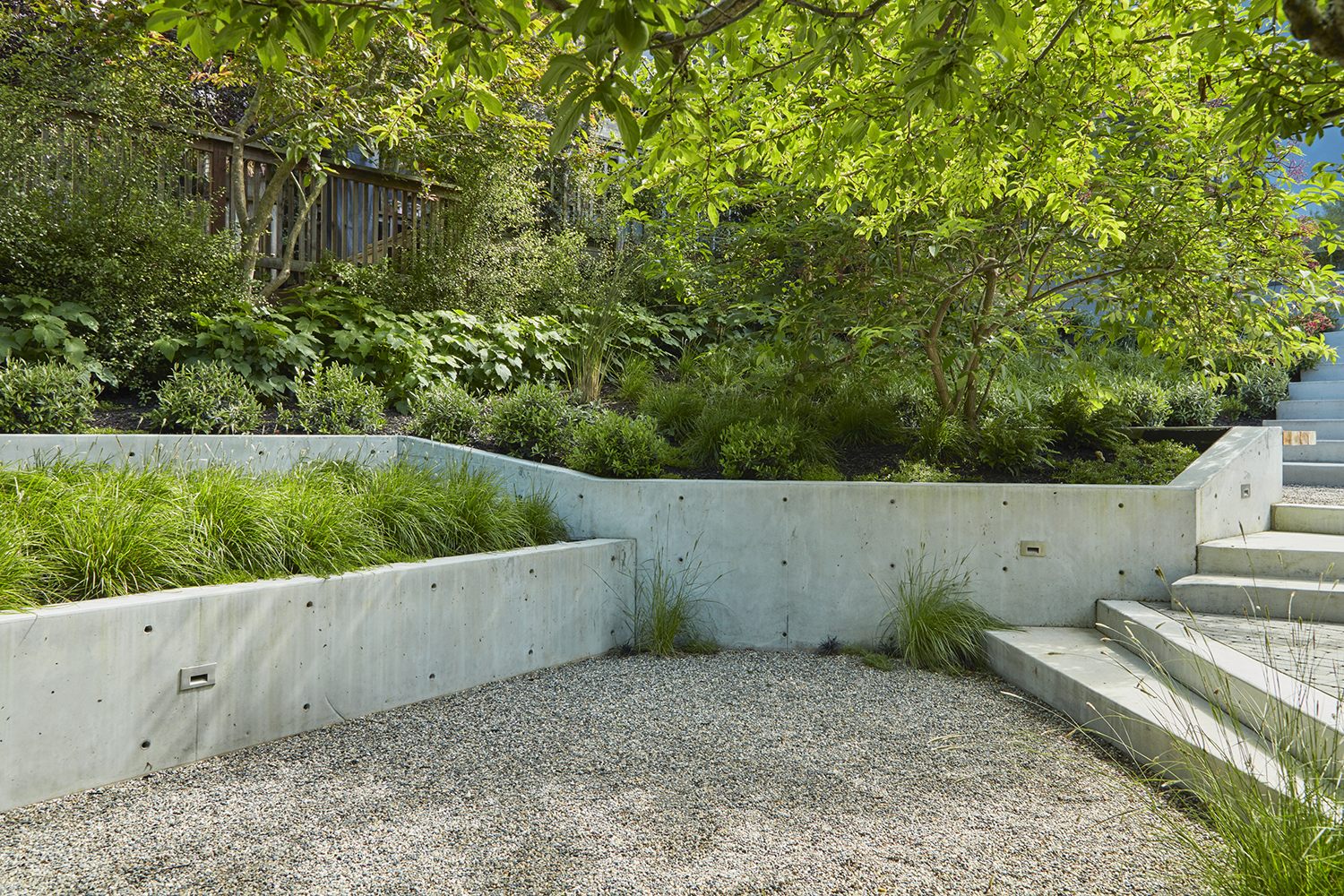
The great thing about walls is that they are solid, and therefore very good at holding back soil, blocking out noise and neighbors. The bad thing about walls, however, is that they are solid - visually, that can look a little ‘blocky’.
For this garden, the landscape designer Beth Mullins, founder of California-based practice Growsgreen Landscape Design, designed a herb box wall, which, as well as providing a growing patch close to the kitchen, also creates an ample slice of green instead of a big lump of concrete.
“The box creates a nice visual vertical element and bookends the area,” says Beth. “It's a nice way to take up space vertically in a smaller garden.”
To ensure good drainage in the wall, Beth planted the herbs into plastic flower bed trays, which were then inset into metal-lined trays with a drainage outlet (this comes out the back of the fence and down to the ground). The herb box wall is a versatile solution, she adds: “It would also work on a deck, a balcony, a roof garden, or you could use it as a screen.”
3. Use a wall as a backdrop to highlight plants
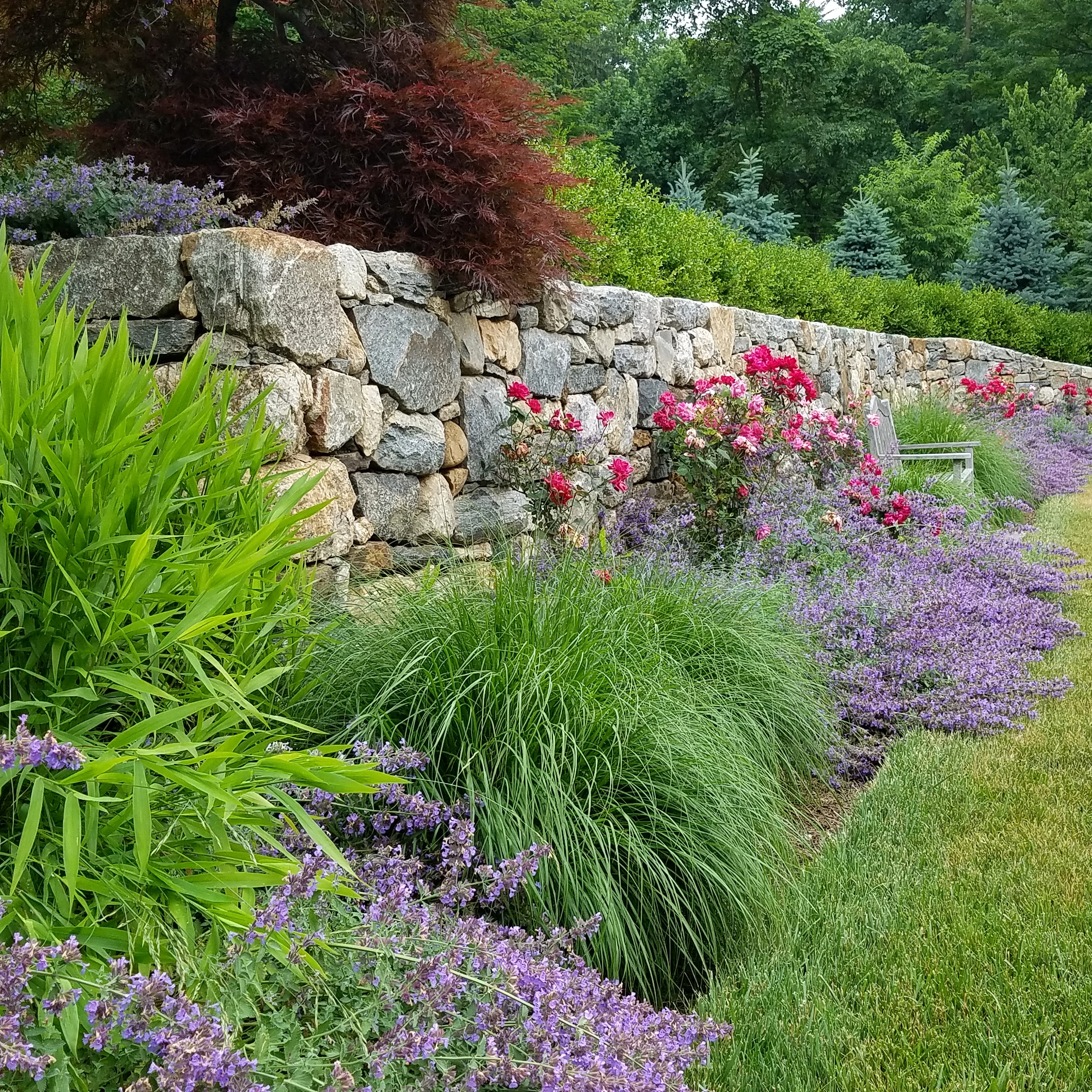
“Garden walls serve as wonderful backdrops for plants and trees,” says the New York-based landscape designer and author Jan Johnsen, founder of Johnsen Landscapes & Pools.
In this steeply banked private garden, the wall was built in order to create a level area in front of it and retain the soil behind. “We used local fieldstones, and made it look like a dry stone wall but it is actually mortared and sits on a concrete footing.”
Jan then used the flower bed to plant roses, dwarf fountain grass and catmint in front of it. “There is nothing as lovely as a beautiful wall to set off a garden bed,” she says. What’s more, the flowers serve to break up the heaviness of a solid wall. “Color always helps a gray stone wall,” Jan says.
4. Create a focal point with a wall fountain
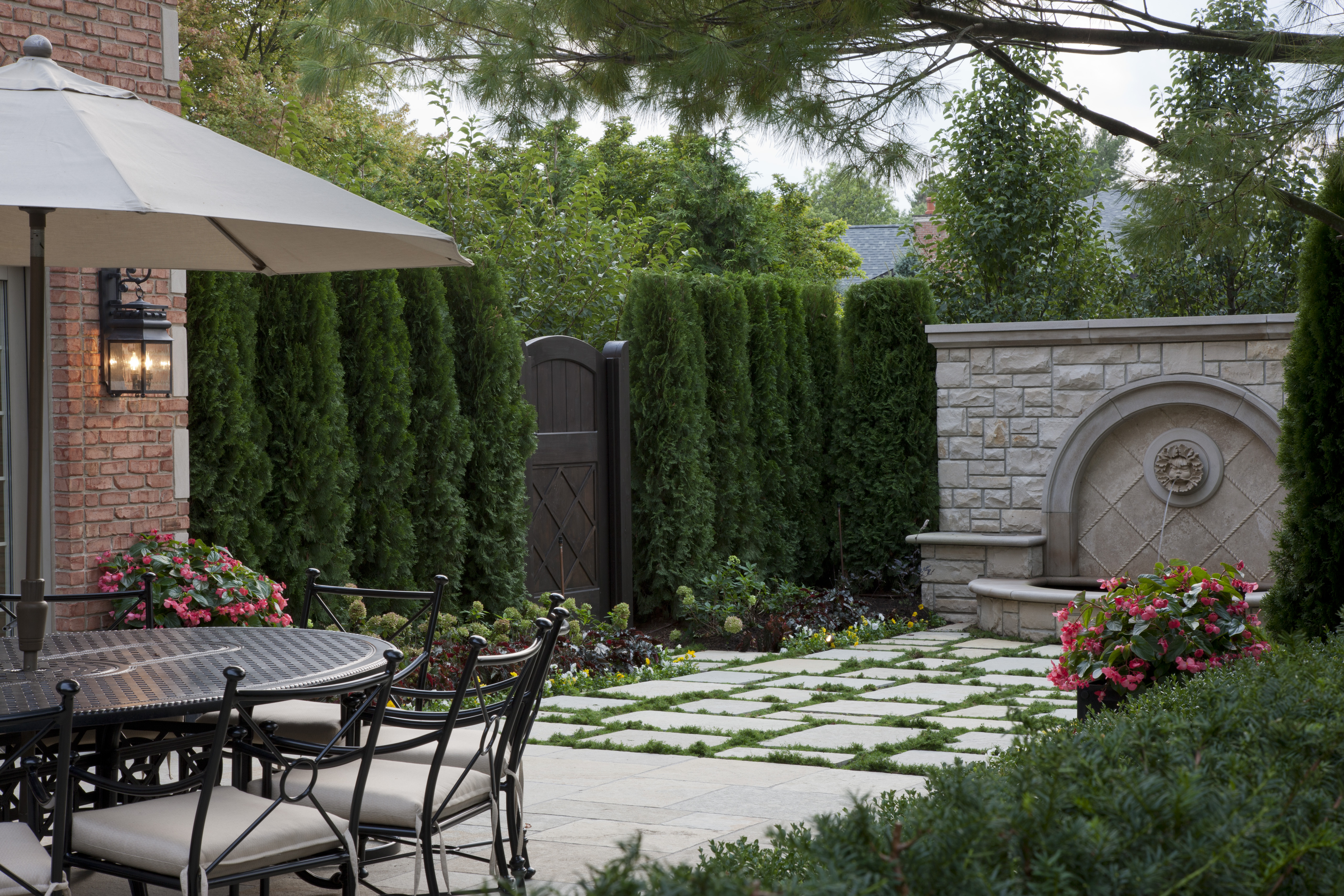
Design by Patrick Zaremba
Adding a wall fountain is a wonderful way of introducing softness into an otherwise hard feature. In this luxurious private estate in Bloomfield Hills in the Detroit suburbs, the limestone wall fountain conceals a view into the neighbor’s property.
“This could have been achieved by planting,” says the Michigan-based landscape designer Patrick Zaremba, who oversaw the design of this expansive residential landscape. However, he adds, “the idea of the wall fountain was to provide an attractive focal point as a tranquil sitting area of the garden; a place to escape and retreat to.” Calleryana “red spire” trees provide a nice backdrop of curtain flowering in the spring, dense glossy leaves in summer, and then a stunning red color display in the fall.
Layered in front are hydrangea paniculata, “providing a pop of color and flowering”, and lasting from summer to fall.
5. Build a grill into the wall
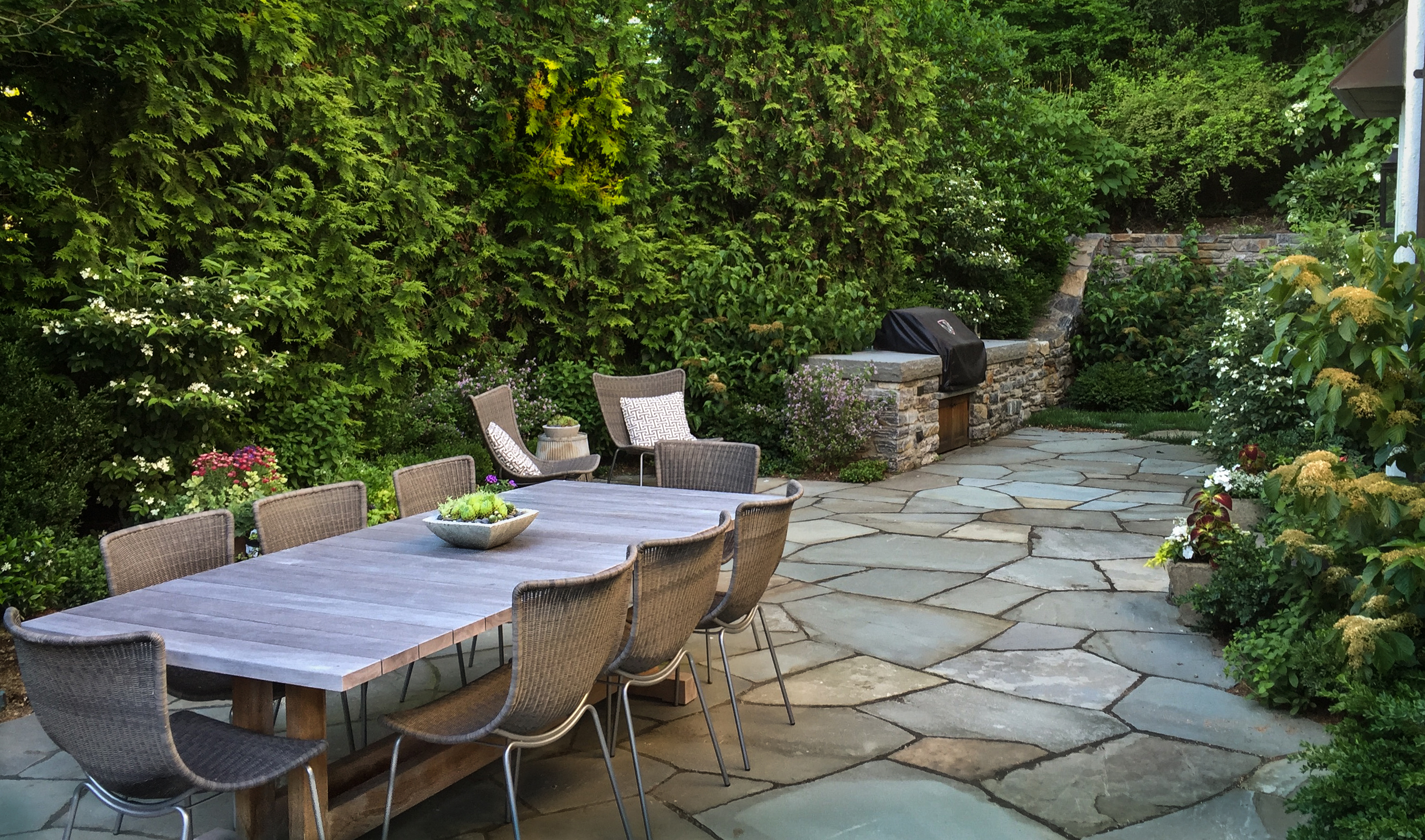
The best gas grill can transform your summer entertaining, but its bulky size will also most likely dominate your patio. For this luxury residence in Lower Westchester County, the renowned East Coast landscape architect Renée Byers found a neat solution - to embed the grill into the retaining wall.
Every last detail has been considered to ensure a seamless fit: Renée designed wooden cabinetry to sit beneath the grill to house the gas line and canisters so that they’d be entirely out of sight. She also factored in ample counter space on both sides of the grill by inserting two hefty slabs of bluestone, which, she adds, “is honed on top and super smooth”.
To ensure the wall was visually cohesive all around, Renée kept the width of the wall uniform so that it matched that of the grill. The rocks used for the wall were specifically chosen to look “as though they’d been quarried from the natural rock outcrops that occur in this village,” says Renée. She advises positioning the grill close to the kitchen door, as well as ensuring it’s not facing the primary dining area: “You want it very close, but not the main feature.”
6. Repurpose a fallen tree to make a log wall
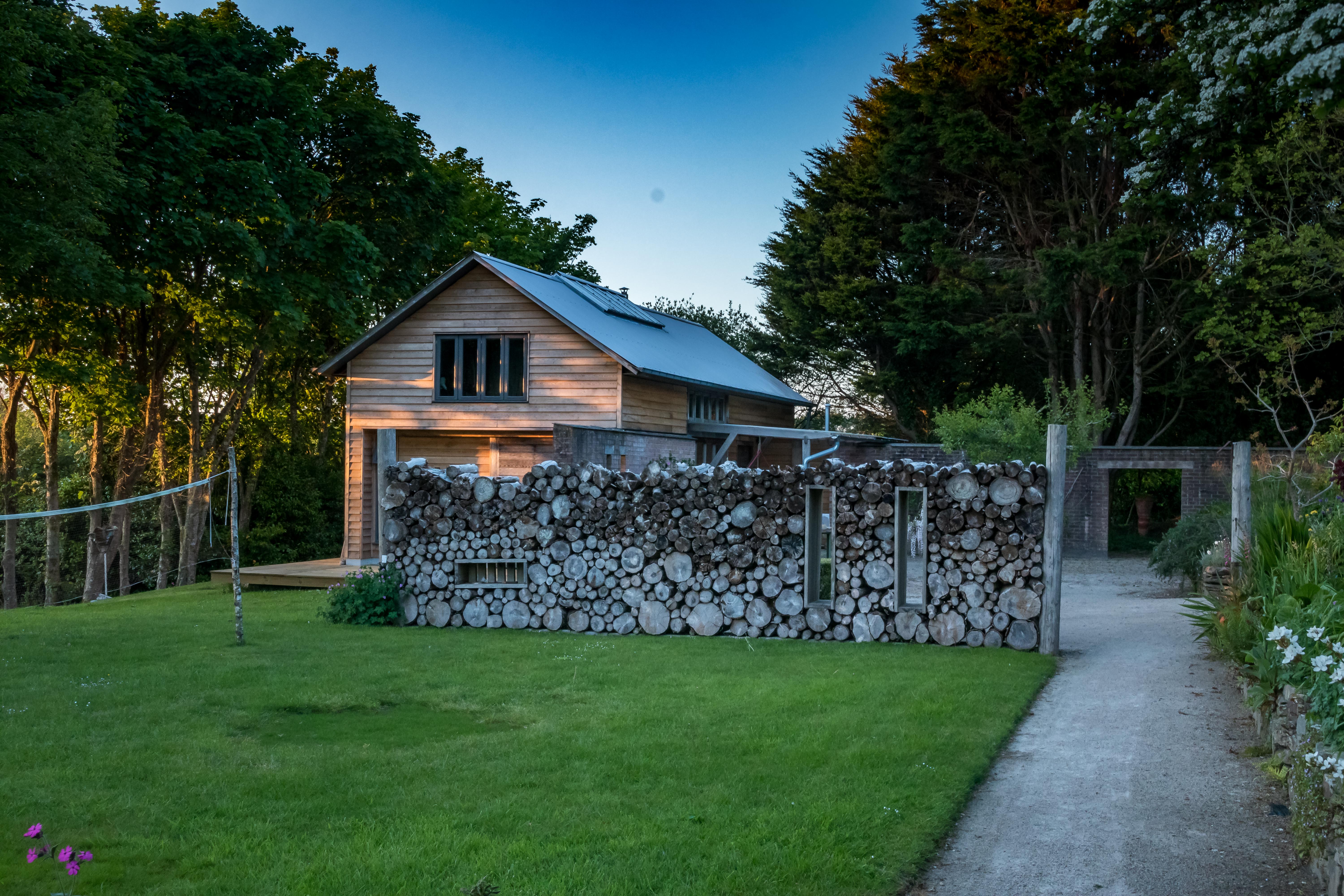
In Cornwall, England - affectionately known as the English Riviera for its balmy climate and extensive coastline - there is a magical garden (and cafe, workshops, artists’ studios) that has risen from a derelict, bramble-choked plant nursery. R
un by volunteers, every gardening act at Potager Garden is carried out in harmony with nature; nothing goes to waste, and everything is done as sustainably as possible. So when a cluster of conifers that had grown too large and were creating too much shade needed to come down, their trunks were repurposed to create this handsome log wall.
“The wall was built to help to create separate 'rooms' within the garden,” explains Mark Harris, co-owner of the Potager Garden. The structure is as simple as it looks: “But we laid a foundation of bricks to keep the logs off the ground so that they would last longer.”
Glass windows were added to give “an architectural dimension”, says Mark, “lifting the structure above a simple pile of logs. They frame new views of the garden, and are great fun for kids to squeeze through.” Of course no unprotected wooden structure will last forever, so Mark suggests taking a philosophical attitude: “Better to enjoy seeing the structure change its character over time and accept that you'll get to do it all again in 15 or 20 years.”
7. Plant a partial green wall
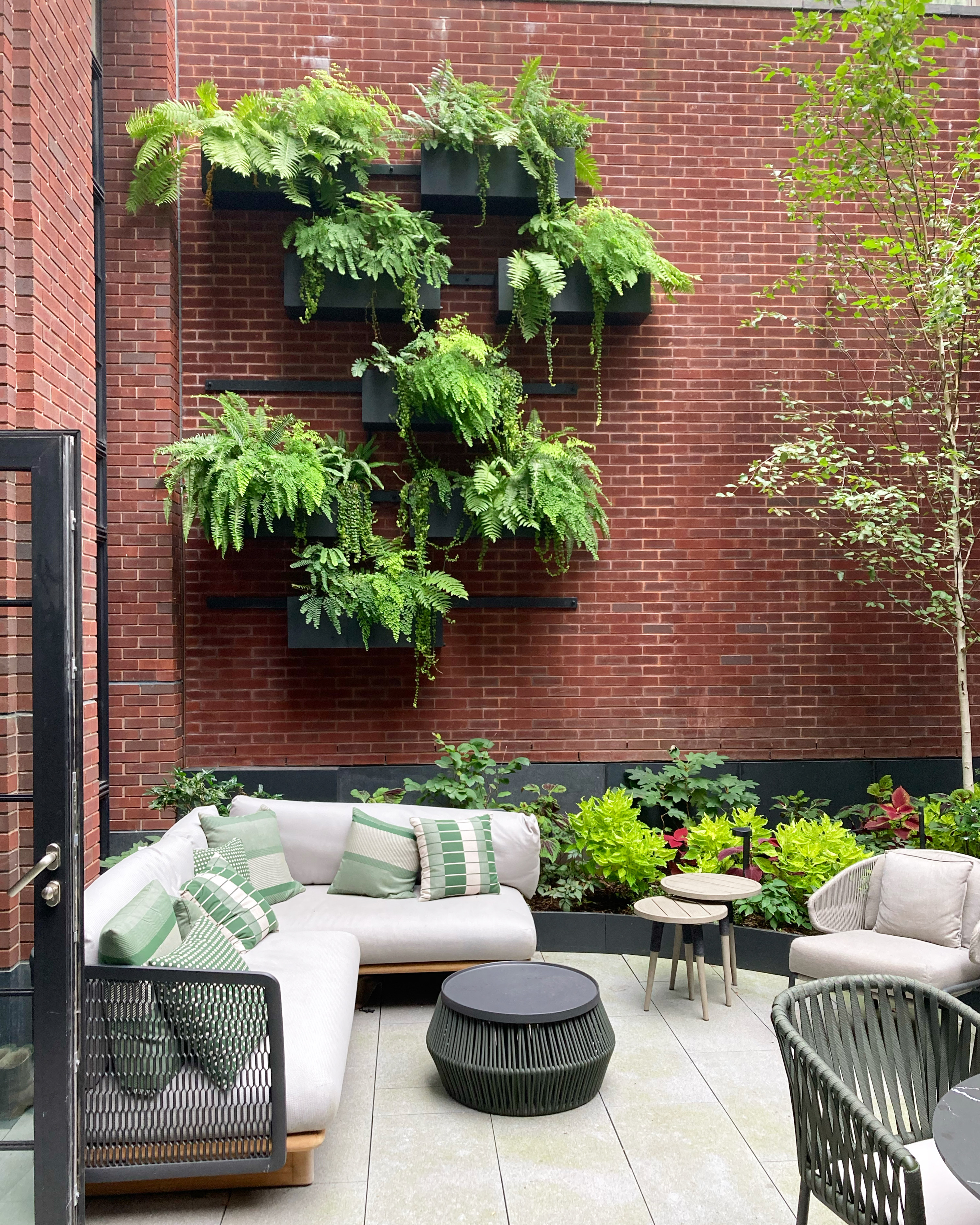
Design by RKLA Studio and Blue in Green Gardens
An attractive red brick wall can be a lovely asset to an outdoor space, but you can have too much of a good thing. RKLA Studio, the New York City-based designers behind this fern wall in Greenwich Village, have cleverly broken up this towering expanse of red brick here with boxes of ferns.
“More than simply disguise the brick, the clients wanted to take advantage of the verticals offered by the space by adding plantings in boxes,” says Naima Green, founder of Blue in Green Gardens, the landscape design and maintenance firm that installed it.
“The delicate form and varying shades of green of the ferns, against the hard lines of the metal boxes and backdrop of brick is quite breathtaking by the end of the season.” Plus it has the added advantage of significantly increasing what was quite a small garden footprint: “It’s become a focal point of the entire space - a conversation piece,” she says. Ferns were chosen because it’s a very shaded space. Naima planted a mix of perennial ferns like Christmas fern and marginal wood fern, as well as annual ferns like Maidenhair fern that created “a draping effect that stands out even from the inside”, she says.
8. Build a dry stone wall

The beauty of a dry stone wall - constructed by hand without any binding mortar - has been recognised for millennia, with the technology dating back to Neolithic times.
In fact, the purpose of this freestanding limestone wall in a luxury residence in Michigan is primarily decorative, explains its designer Patrick Zaremba of Zaremba & Co. “With its rugged textures juxtaposing the thick green grass, it serves as a simple yet powerful focal point,” he says.
However, he adds, “As it’s located between the street and the house, it is also wonderful at sound and light deflection from passing cars.” Select pieces of limestone were skillfully hand chiseled into various shapes and sizes to fit together into this clean yet rustic pattern. The use of larger stones was, says Patrick, “to give the wall a more substantial structural integrity - which also provides a nice aesthetic byproduct.”
9. Use a wall for extra seating
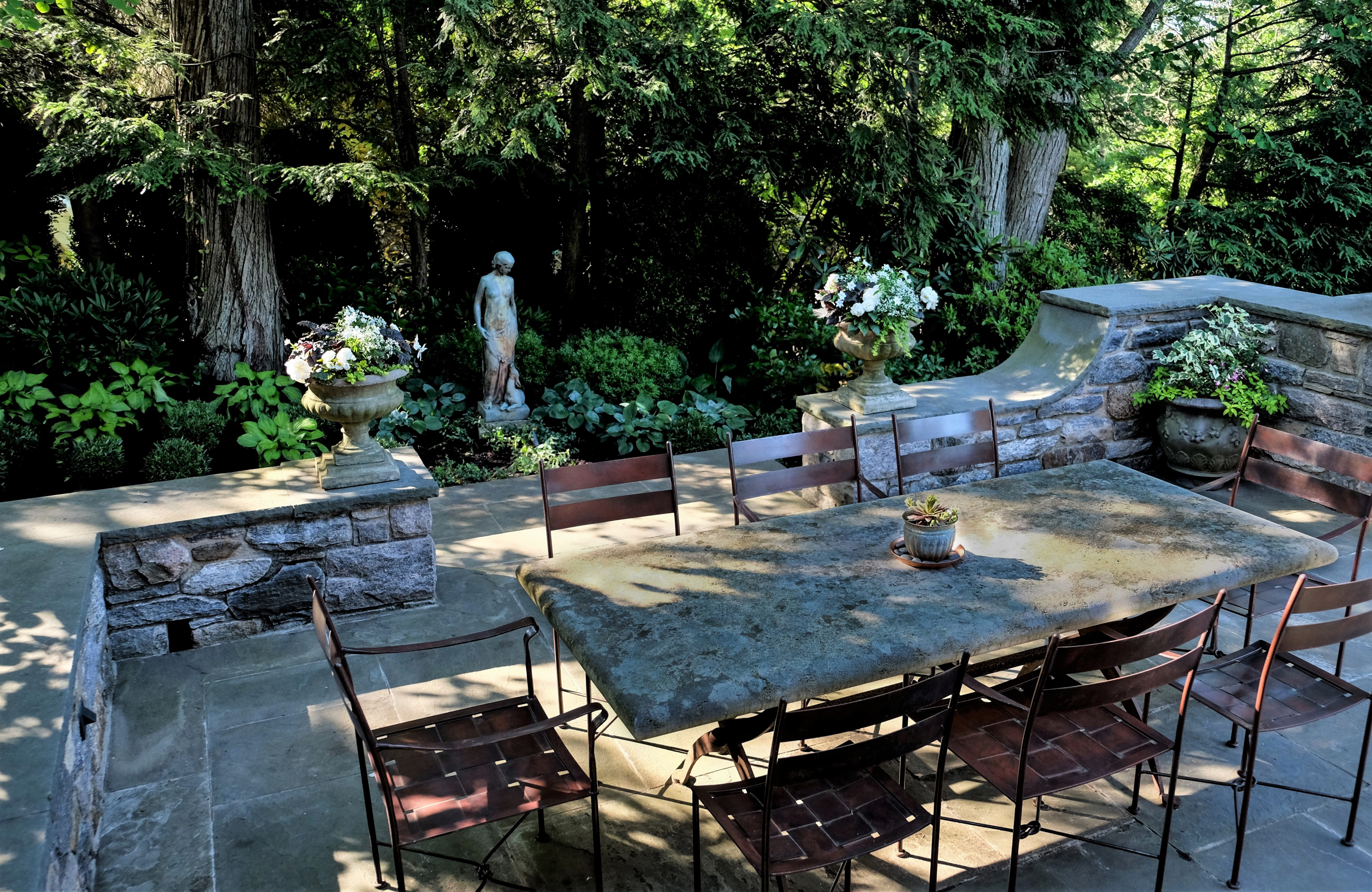
A perfectly judged wall, positioned just at the height that makes it easy for you to perch comfortably for as long or as little as you choose, is a much under-rated feature in a garden.
In this 1928 Jacobethan Revival house in New York by the acclaimed architect Lewis Bowman, the landscape architect Renée Byers designed the stone wall with numerous purposes in mind, not least the chance to sit. Because it’s necessarily a casual seating provision, it invites guests to move around and mingle - they needn’t feel too committed here. The granite wall, selected to match the stonework of the historic house, is also a perfect spot for the host to have a quick sit-down, as well as provide a useful overspill for busier events.
The wall also provides a frame to the dining area, explains Renée; “It encloses the space as an outdoor room.” Plus it houses the outdoor grill (just out of sight here). Renée broke up any potential heaviness of the wall by creating a centered opening, which also frames the vintage statues and annual flowers, and at night, the inbuilt lights in the wall add a sparkling, magical ambience.
10. Use a wall for concealment
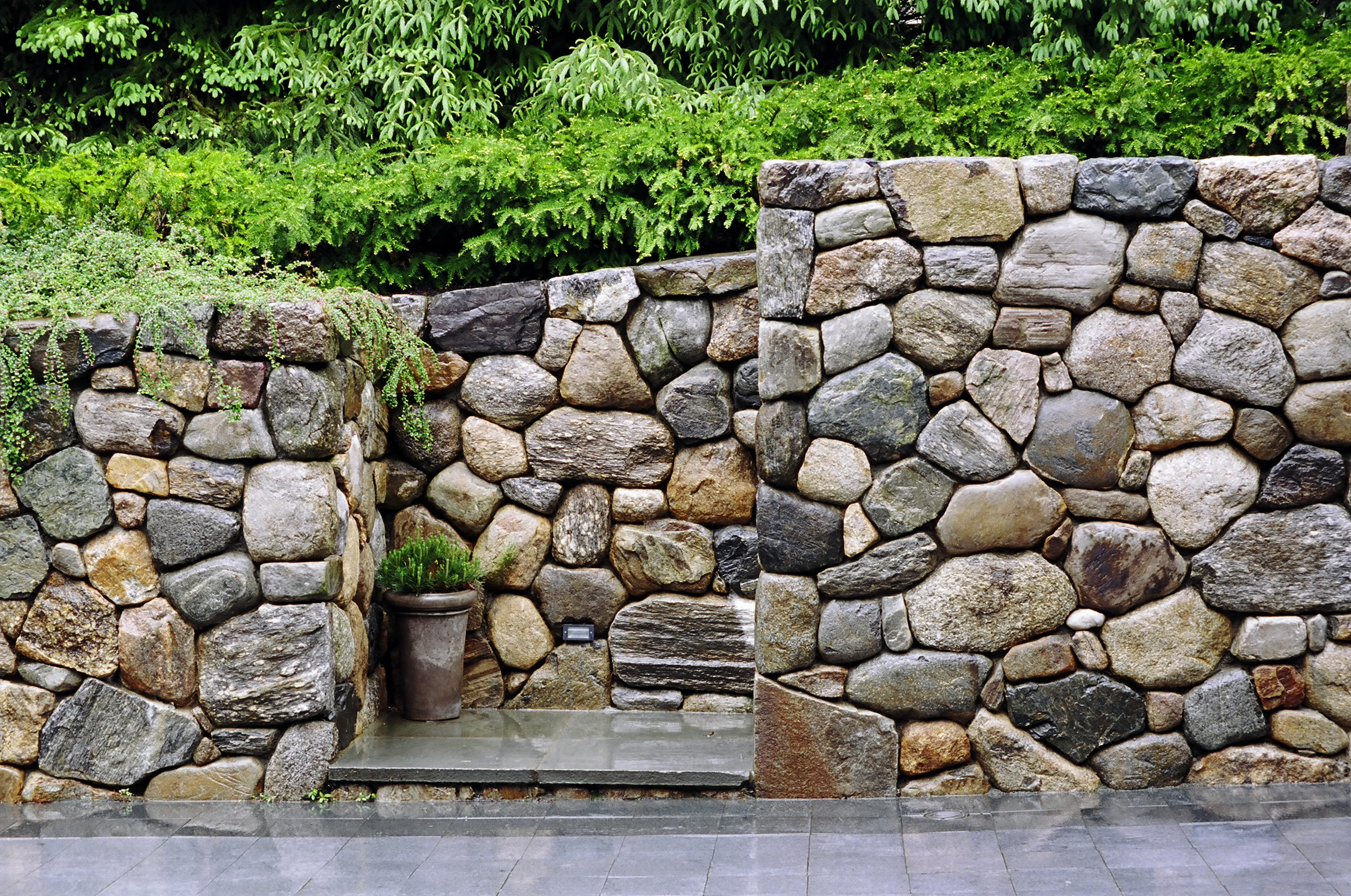
You wouldn’t guess it, but just off this recess is a staircase up to the main house of a new Boston residence. “The recess in the wall is the landing of a set of steps that leads to the upper level of the house and guest quarters,” explains the landscape architect Clara Batchelor, founder of Massachusetts-based CBA Landscape Architects. “We didn’t want to draw attention to the steps, so they are hidden behind the wall to the right.”
On either side of the stairs is actually a double wall, one side to hide the steps and one to hold back the steep hill, into which the newbuild is nestled. The wall structure is concrete and faced with stones native to New England: “The stones and style were selected to match the stone foundation of the house,” Clara says, “and were hand laid - put together like a puzzle to minimize the voids between stones.”
How can I hide a brick wall in my garden?
If you don’t want to go all out and plant a living wall, you could plant some vigorous vines to hide a brick wall, recommends Naima Green, founder of New York City-based landscape design firm Blue in Green Gardens.
“In NYC, we use Hedera helix (English Ivy) for a fast-growing evergreen option, and I love Parthenocissus tricuspidata (Boston Ivy), as it has a very interesting leaf shape, and the fall color is absolutely stunning.”
If you want quick cover, she recommends climbing hydrangea (hydrangea petiolaris var. anomola) and false climbing hydrangea (Schizophragma hydrangeaoides): “They can scramble up a brick wall relatively quickly.”
Be The First To Know
The Livingetc newsletters are your inside source for what’s shaping interiors now - and what’s next. Discover trend forecasts, smart style ideas, and curated shopping inspiration that brings design to life. Subscribe today and stay ahead of the curve.
Fleur Britten is a well-respected journalist who for years was the Senior Features Editor at Sunday Times Style. She is known as one of the smartest lifestyle journalists around, revered for being able to decode trends and report on new zeitgeists as they happen. She now writes for the Telegraph, Livingetc, Vogue, The Times, Harper's Bazaar and the Guardian.
-
 5 Bathroom Layouts That Look Dated in 2025 — Plus the Alternatives Designers Use Instead for a More Contemporary Space
5 Bathroom Layouts That Look Dated in 2025 — Plus the Alternatives Designers Use Instead for a More Contemporary SpaceFor a bathroom that feels in line with the times, avoid these layouts and be more intentional with the placement and positioning of your features and fixtures
By Lilith Hudson Published
-
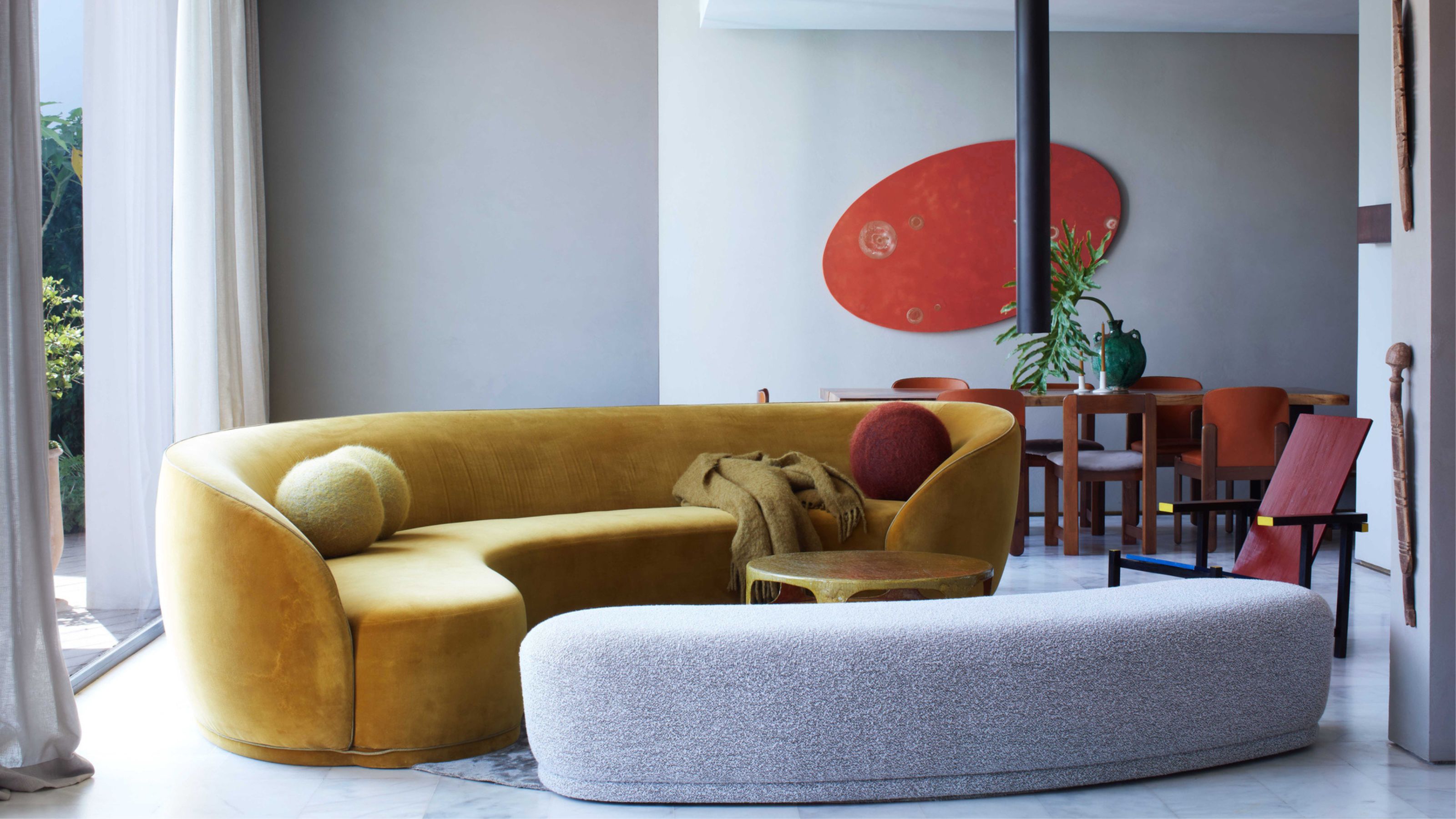 Why Decorating With Mustard Yellow Helps Fill Your Interiors With a Sense of "Confident Calm"
Why Decorating With Mustard Yellow Helps Fill Your Interiors With a Sense of "Confident Calm"There is so much more to decorating with this turmeric-tinted sauce-wiggled-on-a-hotdog not-quite-yellow shade than meets the eye
By Amy Moorea Wong Published